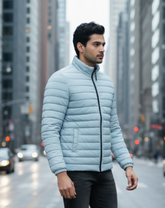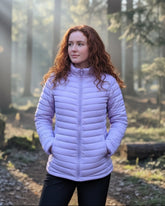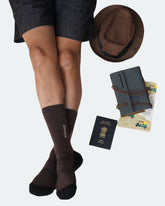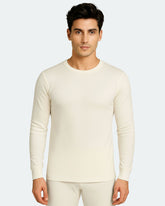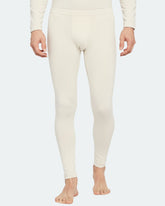Winter Attire Guide for Climbing Kilimanjaro
Winter Attire Guide for Climbing Kilimanjaro
Climbing Mount Kilimanjaro is an incredible adventure with stunning views and a massive sense of accomplishment. As you prepare for this remarkable journey, it’s crucial to consider the varied weather conditions you’ll face. Kilimanjaro’s climate ranges from humid rainforests at the base to icy, snow-covered peaks at the summit. Each zone requires different clothing to keep you comfortable and safe.
Packing for a place with many climates can be overwhelming, especially when keeping your gear light. So, in this blog, we’ll help you figure out precisely what you need in your Kilimanjaro packing list, ensuring you stay comfortable and prepared for all the challenges the mountain has in store.
Unveiling the Chameleon: Understanding Kilimanjaro's Diverse Weather

Kilimanjaro, Africa's crown jewel, is more than just a towering peak. It's a climatic chameleon, transforming its weather patterns with every step you take upwards. As you ascend this majestic mountain, temperatures plummet, landscapes morph, and conditions can change on a dime. Understanding this unpredictable nature is crucial for any aspiring climber. Here's a breakdown of Kilimanjaro's diverse weather zones to help you pack right and ensure you're prepared for the adventure ahead:
A Spectrum of Climates:
Imagine a journey through distinct climatic zones, each with its unique character. Here's a breakdown of what to expect as you ascend Kilimanjaro:
- Cultivation Zone (800m-1,800m): Lush greenery and warm temperatures (20°C to 30°C or 68°F to 86°F) define the lower slopes. This is Africa's embrace – humid and comfortable, a stark contrast to what awaits higher up.
- Rainforest Zone (1,800m-2,800m): As you climb, mist and rain become more frequent, with temperatures dropping noticeably (15°C to 25°C or 59°F to 77°F). This zone can feel like a perpetual twilight, shrouded in a mystical veil.
- Moorland Zone (2,800m-4,000m): The landscape transitions to a cooler and drier moorland. Daytime temperatures hover between 10°C and 20°C (50°F to 68°F), but nights can be surprisingly cold, especially at higher elevations. Prepare for a taste of winter here.
- Alpine Desert Zone (4,000m-5,000m): Sparse vegetation and significant temperature swings define this high-altitude desert zone. Daytime can vary between 5°C and 15°C (41°F to 59°F), but nights plummet well below freezing. Be prepared for dramatic shifts and a true test of your adaptability.
- Arctic Zone (Above 5,000m): Uhuru Peak, Kilimanjaro's summit, resides in this unforgiving zone. Here, temperatures can drop to -10°C to -20°C (14°F to -4°F) or even lower. Strong winds and low oxygen levels add another layer of challenge. This is the realm of winter mountaineering, demanding respect and proper preparation.
Kilimanjaro's weather can be unpredictable. Understanding the climatic zones and preparing for various conditions is essential to conquer the mountain. Remember, your Kilimanjaro packing list should include the right layers and proper gear. Your gear for climbing Kilimanjaro has to include insulated clothing, a good sleeping bag, and a waterproof jacket, for a safe and comfortable climb.
Mastering the Mountain: The Best Time to Climb Kilimanjaro’s Snowy Peaks
What is the best time to ascend Africa's Roof? Here's a breakdown to help you plan your perfect winter conquest:
Embrace the Winter Wonderland (December to February):
- Temperatures: Winter brings a crisp challenge, with nights dipping to a bone-chilling -5°C (23°F) and daytime highs hovering around freezing (0°C or 32°F). Prepare for significant wind chill that can make it feel much colder, especially at higher altitudes.
- Snowy Slopes: Imagine a breathtaking landscape transformed by a blanket of snow. Winter transforms Kilimanjaro into a wonderland, offering stunning scenery and demanding proper winter gear and experience.
- Smaller Crowds: Unlike the summer rush, winter offers a more solitary experience. Enjoy the tranquility of the mountain with potentially fewer fellow adventurers on the trails.
Considering Alternatives: Beyond Winter's Embrace
Kilimanjaro offers opportunities for year-round ascents, each season with its unique charm:
- January to March (Dry Season): This pre-winter period boasts warm temperatures (17°C to 27°C or 63°F to 81°F) and clear skies, with generally less crowded trails compared to the peak summer months.
- June to October (Dry Season): This popular climbing season offers cooler daytime temperatures (averaging around 21°C or 70°F) than the early dry season. However, expect larger crowds, especially in July and August.
- Wet Season (March, April, November): While not ideal, the wet season offers the advantage of potentially encountering fewer climbers. Be prepared for muddy conditions on the lower slopes. The Rongai Route on the Kenyan side might be a good option for potentially less rain and a less technical climb during this time.
Full Moon Magic:
For an unforgettable experience, consider a climb under the ethereal glow of a full moon. The lunar light illuminates the dramatic landscape, creating a sense of awe as you navigate the final summit push. This typically begins around midnight. However, since full moon climbs are significantly more popular expect to share the magic with a larger group.

Charting Your Course: Choosing the Best Route to Kilimanjaro
Kilimanjaro's diverse landscapes and climates offer a variety of routes to suit different climbing preferences and experience levels. Here's a breakdown of some popular routes, highlighting their unique features to help you choose the perfect path to Uhuru Peak:
A Climber's Compass: Exploring Kilimanjaro's Routes
- Marangu Route (Coca-Cola Route): This well-maintained route is the shortest and most popular option, offering a gradual ascent and comfortable hut accommodation. However, it can feel crowded due to its popularity. It’s a 5 to 6 days long trekking route with a moderate difficulty.
- Machame Route (Whiskey Route): This scenic route traverses a variety of Kilimanjaro's ecological zones, offering stunning views and a more adventurous feel. It's 6 to 7 days long and it can be on a level of moderate to challenging trek.
- Lemosho Route: This lesser-traveled route provides a more remote and wilderness experience with breathtaking views. The longer acclimatization period makes it a good choice for first-time climbers. It’s approximately a 7 to 8-day trek by this route with a difficulty level of moderate.
- Rongai Route: Accessed from the Kenyan side of Kilimanjaro, this route offers a unique perspective and a drier climate, especially during the rainy season. It takes about 6 to 7 days to complete the trek by this route and the difficulty level for this route is considered moderate.
- Umbwe Route: The most challenging route, Umbwe is known for its steep climbs, unpredictable weather, and lack of permanent huts. Experienced climbers seeking an adventure will find this route rewarding. (Length: 5-7 days, Difficulty: Challenging) The time taken to complete this route is 5 to 7 days with the highest difficulty level of challenging.
Choosing Kilimanjaro Routes for Winter
Winter ascents on Kilimanjaro offer a unique challenge and breathtaking scenery. However, some routes are better suited for winter conditions than others. However, selecting the right path and climbing company is crucial for safety and enjoyment. Here are our top picks for routes and recommended companies for your winter climb:
Machame Route: Known for its stunning variety of landscapes and good acclimatization profile, the Machame Route shines in winter. For this challenging route during the colder months, we recommend Odati Adventures, known for their experienced guides and excellent safety record.
Lemosho Route: With its extended acclimatization period and drier conditions on the Kenyan side, the Lemosho Route is ideal for winter. One in an Orange Jacket offers tailored experiences perfect for tackling this route in colder weather, providing personalized attention and expert guidance.
Rongai Route: As the driest route, Rongai is a solid choice for those looking to avoid heavy snowfalls, yet it poses challenges such as a higher risk of avalanches in winter. Adventure Pulse excels in preparing climbers for these conditions, ensuring a safe and memorable ascent.
Each of these routes offers its own unique set of challenges and scenic rewards in winter. Be sure to partner with a reputable company that aligns with your experience level and climbing goals. Prepare well, and you're set for an unforgettable adventure that will push your limits and offer spectacular views of Kilimanjaro's winter wonderland.
The Ideal Route for You
The best route for you will depend on your experience level, fitness level, and desired level of adventure. Here are some additional factors to consider:
- Acclimatization: Some routes, like the Lemosho Route, offer longer acclimatization periods, which can benefit first-time climbers.
- Crowds: Some routes, like the Marangu Route, can be crowded, while others, like the Lemosho Route, are more remote.
- Scenery: Some routes, like the Machame Route, offer a variety of landscapes, while others, like the Rongai Route, are more focused on the mountain itself.
- Cost: Some routes, like the Marangu Route, are more affordable than others, like the Lemosho Route.
Ultimately, the best way to choose the ideal route for you is to do your research and talk to a reputable tour operator. They can help you match your goals and preferences to the best route for you.
Essential Tips for a Successful Summit

Reaching the summit requires careful planning, an understanding of the mountain's unique challenges, and, of course, the right gear. Here's a breakdown of crucial factors to ensure your Kilimanjaro climb is a triumphant success while looking sharp and feeling comfortable in any condition.
- Embrace the Power of Acclimatization: Kilimanjaro's high altitude presents a significant risk of altitude sickness. The key to preventing this is a gradual ascent. Choose a route specifically designed for acclimatization, allowing your body ample time to adjust to decreasing oxygen levels.
- Hydration is Your Hero: Staying well-hydrated is important on any climb, but especially so on Kilimanjaro. Make water your constant companion, ensuring your body functions optimally throughout the trek. Consider a high-quality hydration pack for easy access on the move.
- Fuel Your Adventure: Proper nutrition is essential for providing the energy needed to conquer Kilimanjaro. Many tour operators offer exceptional meals to keep you fueled throughout your climb. But don't forget to pack energizing snacks you can rely on in between meals.
- Listen to Your Body: While physical fitness is important, listening to your body's signals is crucial. Be mindful of any discomfort and don't hesitate to communicate concerns to your guide.
- Expert Guidance Every Step of the Way: You're never truly alone on Kilimanjaro. Qualified guides, porters, and a Kilimanjaro tour operator for your support team, ensuring your safety and maximizing your chances of summit success.
- Conquer Kilimanjaro in Comfort and Style: Kilimanjaro's diverse climate demands a layering system of high-performance apparel that protects you from the elements while maintaining peak comfort. Expertly designed warm thermals, breathable outerwear, and technical accessories ensure you conquer not just the mountain, but the elements in style. Look at yourself reaching the summit feeling confident and prepared, ready to capture breathtaking photos without sacrificing warmth or performance.
Following these essential tips and outfitting yourself with the right technical clothing will equip you to conquer Kilimanjaro and experience the thrill of reaching Africa's highest peak. Let us help you write your Kilimanjaro story in comfort and style.
Know your right Winter clothing for Kilimanjaro
Kilimanjaro's winter ascent presents a unique challenge – majestic snow-capped peaks, breathtaking landscapes, and frigid temperatures. Proper winter attire is essential to conquer the mountain in comfort and safety. Here's a breakdown of the key clothing items you'll need to brave the elements and reach the summit:
Layering Up for Success:
The key to staying warm on Kilimanjaro is layering. This allows you to adapt to the changing temperatures as you ascend. Here's a look at the essential layers:
- Base Layer: Moisture-wicking thermals for women and thermal wear for men are your first line of defense. Choose merino wool that wicks away sweat and keeps you dry. This is crucial for comfort and preventing hypothermia.
- Mid-Layer: A fleece provides essential insulation. Consider the weight and packability – you'll want something warm but not bulky. Our quarter-zipper mid-layer tee is perfect for this purpose
- Outer Shell: A high-quality waterproof and breathable outer shell is vital for shielding you from wind, snow, and potential rain. Seam-sealed construction and a good hood are essential features. Consider a winter jacket with good ventilation options for managing sweat during exertion.
Winter Apparel Must-Haves:
- Insulated Pants: Durable waterproof winter hiking pants are crucial for protecting your legs from the elements. Look for features like articulated knees, snow gaiters, and reinforced bottoms for added durability.
- Warm Gloves: Having a good selection of gloves is essential. Consider a liner glove for warmth and a waterproof outer shell for protection against snow and wind. An additional pair of heavy mittens for summit night provides extra warmth.
- Thermal Headwear: A warm beanie and a neck gaiter are crucial for retaining heat. Look for merino wool or fleece options for comfort and breathability.
Additional Considerations:
- Footwear: Invest in a sturdy pair of hiking boots designed for winter conditions. Look for features like good insulation, waterproof materials, and aggressive treads for traction on snow and ice. Gaiters are highly recommended to keep snow out of your boots.
- Socks: Pack at least 4 to 5 pairs of warm hiking socks made from merino wool. Consider layering liner socks with thicker hiking socks for added warmth and comfort.
- Hand and Toe Warmers: These can be lifesavers during the coldest stretches of your climb. Make sure to pack warm, insulated gloves along with enough hand and toe warmers to use throughout the day and especially for summit night.
By carefully selecting your winter attire and layering strategically, you'll be well-equipped to conquer the elements and experience the thrill of a successful Kilimanjaro winter ascent. Remember, the right clothing is an investment in your safety and comfort, allowing you to focus on the adventure and the breathtaking views that await you on the "Roof of Africa."
Kosha The Kilimanjaro Outfitters
Gear up for your Kilimanjaro adventure with Kosha's premium winter wear. Stay warm, comfortable, and prepared as you tackle the mountain’s ever-changing conditions. Here’s what to pack to make your climb an unforgettable experience!
Base Layer: Kosha's Thermal Wear
The base layer is your first line of defense against the cold. Kosha's thermal wear, including thermal tops and bottoms, is designed to provide optimal warmth and comfort.
Thermal Tops: Kosha's thermal tops are crafted from high-quality merino wool and bamboo blend. Merino wool is known for its excellent moisture-wicking properties, keeping you dry even during intense physical activity. These are temperature regulating hence you don't need to worry about the elevation, climate, or the time of the day. Additionally, it's naturally odor-resistant, which is a significant advantage during a multi-day climb. Our thermals have enhanced durability and ensure a snug fit, providing the perfect balance of comfort and performance.
Thermal Bottoms: Kosha's thermal bottoms are equally impressive. They offer a comfortable fit and excellent insulation, making them ideal for the lower temperatures you'll encounter on Kilimanjaro. Whether you're resting at camp or pushing towards the summit, Kosha's thermal bottoms keep you warm and dry.
Mid Layer: Kosha's Insulating Clothing
The mid layer is all about retaining body heat, and Kosha offers a range of insulating clothing designed for this purpose. These mid-layers are not only functional but also stylish, making them perfect for both trekking and après-hike relaxation.
Kosha's pullover and hoodies are made from premium materials that trap heat effectively while allowing moisture to escape. The lightweight design ensures that you won't feel weighed down, and provides freedom of movement. With a variety of colors and styles, you can look good while staying warm.
Kosha’s fleece-lined sweatshirt is specially designed for cold nights on the mountain. These are a must-have. Filled with ethically sourced down, they offer exceptional warmth without adding bulk.
Shell Layer: Kosha's Protective Outerwear
The shell layer is crucial for protecting against wind, rain, and snow. Kosha's shell layer products are designed to withstand the harshest conditions Kilimanjaro can throw at you.
Kosha's waterproof jackets are made with advanced materials that provide excellent waterproofing and breathability. Features such as adjustable hoods, and ventilation zippers ensure that you remain dry and comfortable, no matter the weather. The lightweight design means you can easily pack it away when not needed. Kosha's parka jacket is an excellent choice for climbing Kilimanjaro. Its thermal lining offers essential warmth, protection, and waterproof, wind-resistant features apart from being super lightweight.
Pair your jacket with Kosha's waterproof pants for full-body protection. These pants are designed to fit comfortably over your base and mid-layers. Reinforced knees and seat areas provide added durability, making them ideal for the rugged terrain of Kilimanjaro.
Winter Accessories: The Finishing Touches
No winter attire guide would be complete without mentioning the essential accessories that can make all the difference in extreme conditions. Kosha offers a range of winter accessories designed to keep you warm from head to toe.
Kosha's merino wool socks are a climber's best friend. They offer excellent insulation and moisture-wicking properties, keeping your feet warm and dry. They have a unique mesh layer for added breathability and making it odor-free. The reinforced heels and toes add durability, ensuring they last through the toughest treks.
Keeping your head warm is crucial, as significant heat can be lost through an uncovered head. Kosha's beanies and monkey caps are made from high-quality materials that provide excellent insulation. The snug fit ensures they stay in place, and the stylish designs mean you can look good while staying warm.
Cold hands can quickly ruin a trek. Kosha's gloves are designed to provide warmth allowing you to handle gear and navigate the terrain without sacrificing comfort. The touchscreen-compatible fingertips are a handy feature, allowing you to use your devices without exposing your hands to the cold.
Final Insight
Climbing Kilimanjaro is an incredible adventure, but it requires careful preparation, especially when it comes to clothing. Kosha's range of thermal wear, mid-layer clothing, shell layer products, and winter accessories are designed to provide the warmth, comfort, and protection you need to tackle this iconic mountain.
Investing in high-quality gear from Kosha not only ensures that you're well-prepared for the diverse conditions on Kilimanjaro but also allows you to focus on the experience and the breathtaking views rather than worrying about the cold. Whether you're a seasoned climber or embarking on your first big trek, Kosha has you covered from base layer to shell, head to toe.
So gear up with Kosha, and get ready to conquer Kilimanjaro in style and comfort. Happy climbing!
Editor’s Picks
Packable Puffer Jacket For Men
- From ₹3,900.00
₹8,400.00- From ₹3,900.00
- Unit price
- / per
Men's Full Sleeves Thermal | Merino Wool + Bamboo
- ₹4,940.00
₹7,600.00- ₹4,940.00
- Unit price
- / per
Alaskan Parka Jacket For Women - Slim Fit
- ₹8,925.00
₹11,900.00- ₹8,925.00
- Unit price
- / per
Lightweight Packable Puffer Jacket For Women
- ₹5,040.00
₹8,400.00- ₹5,040.00
- Unit price
- / per
Men's Merino Wool Cushioned Technical Socks
- ₹1,074.00
₹1,790.00- ₹1,074.00
- Unit price
- / per
